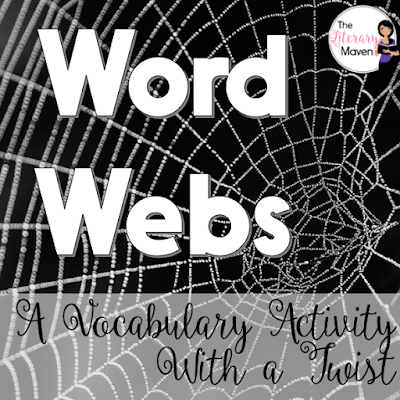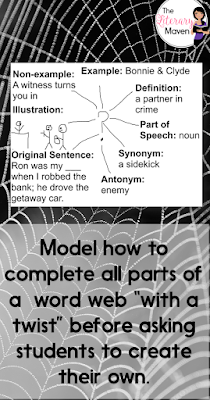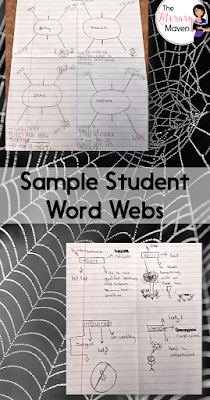Search for Solutions Here:
Word Web Examples | Using Word Webs for Vocabulary
What is a Word Web?
A word web is a graphic organizer that provides more information about a word. Word webs can help children learn new vocabulary words and connect those words to other words that they already know. This is a very effective tool for helping to boost vocabulary and language skills for all children, but especially those with language delays.
For more resources on helping boost vocabulary skills in children, click here.

Vocabulary and Question Flashcards
Basic Vocab and Categories Cards
Word Web Example 1:
Single Word Web
One way to use a word web to expand a child’s vocabulary is to find new words and discuss them at length. You can do this by creating a word web that maps out the new word. Go through a book with the child that is at or slightly above his reading level. Pick out a word from that book that the child doesn’t know the meaning of. You could also do this with an assigned reading from school. Chances are those words will come up again. Draw the following word web on a piece of paper. If desired, stick that paper in a page protector so that you can write on it with dry erase markers and use it again.
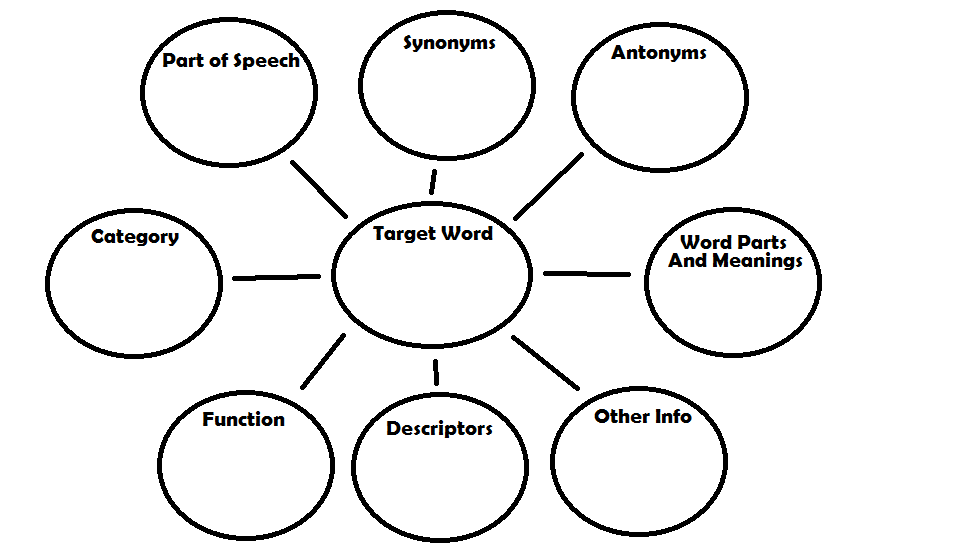
Write the target word in the middle of the word web and then fill in the circles that surround it. Use another piece of paper if you need more room. Here’s what to put in each circle:
Part of Speech:
Include if it is a noun (person/place/thing), verb (action word), adjective (describes a noun), adverb (describes a verb), preposition (location word like on and in), conjunction (combining words like and/but), interjection (ah ha! Or uh oh!).
Synonyms:
Identify words that mean the same thing as the target word.
Antonyms:
Identify words that mean the opposite of the target word.
Category:
If applicable, talk about what category the word belongs to. If it is a noun, use categories like “foods” or “clothing”.
Word Parts and Meaning:
Break the word apart into as many pieces as you can that still have some sort of meaning. For example, the words “balls” can be broken down into the root “ball” and the plural “s”. “Ball” means the object and “s” means there is more than one. For another example, “repositioning” could be broken down into “re” (again), “position” (movement or placing), and “ing” (currently happening). On the other hand, “butterfly” cannot be broken down any further as it is its own thing. If you broke it down into “butter” and “fly”, it would have a completely different meaning. Talk about the parts of the word and what each one means. This will help your child learn to decode other new words when he encounters them.
Function
If it is a noun, talk about the function of that object. If it is a different part of speech, talk about what role the word has in the sentence. For example, the conjunction brings two thoughts together.
Descriptors
For nouns, use the five senses to describe the word. How does it feel, look, taste, sound, and smell? For verbs, include what adverbs you could use to describe the action. For the word run, you could use “quickly”, “slowly”, “staggeringly”, etc.
Other Info
Include any other information that you have about that word.
After creating this word web with a child, he will have a much better understanding of what that word means. You could either erase these pages and start again (such as if you’re using dry erase markers), or put them together into a book for his own personal dictionary.
Word Web Example 2:
Vocabulary Web
If a child is struggling with vocabulary from a particular unit or theme at school, try creating a vocabulary word web for common words that the child might encounter. Here’s what you can do.
Pick a unit or theme and find an age-appropriate text about that topic. You can use the child’s textbook or find a book at the library. Go through the text with the child and pick out 20-30 words that seem to be key vocabulary for that unit. Many textbooks with include a list of key vocabulary at the beginning or end of the chapter. Write all of those words on a piece of paper.
Next, look at the list with the child and see if you can find similar traits that would allow you to group the words into categories on your word web. You could group them by part of speech (see the description above). You could also group them by topic. For example, words about The Earth may be grouped by land, water, and sky.
Once you have some groups in mind, create a word web that has the topic/unit in the middle in a circle. Then create more circles for your groups and have those branching off the topic. Finally, have each word in its own circle that branches off of one group. Here’s an example to get you started:
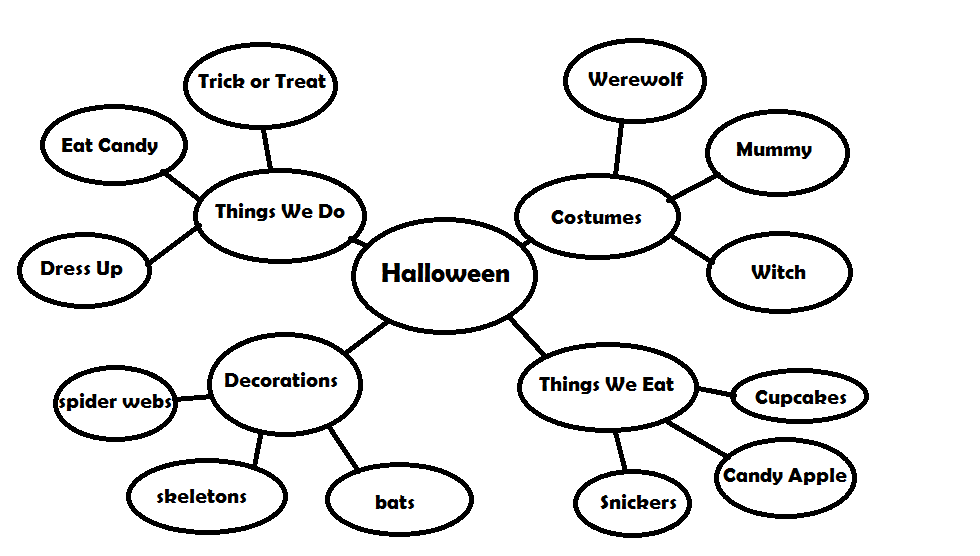
Keep creating these word webs and the child’s vocabulary will grow like crazy! You can even have your child decorate them and hang them where he can review them later.
Additional Resources for Teaching Vocabulary to Children
We have more resources for improving vocabulary skills in children. Check out our other materials here:
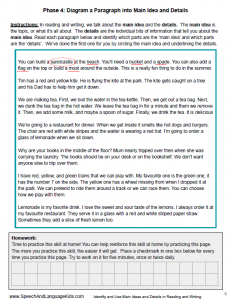
Identifying Main Idea and Details
No-Prep Therapy Materials
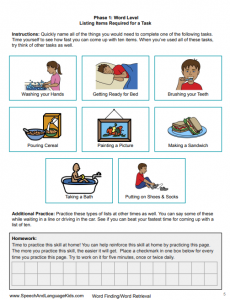
Word Finding Therapy Kit
Activities for Word Retrieval
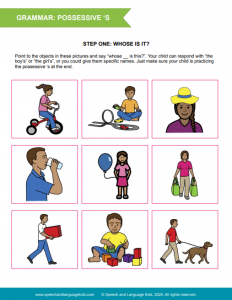
Speech and Language Therapy Guide
Activities for 39 Language Skills

About the Author: Carrie Clark, MA CCC-SLP
Hi, I’m Carrie! I’m a speech-language pathologist from Columbia, Missouri, USA. I’ve worked with children and teenagers of all ages in schools, preschools, and even my own private practice. I love digging through the research on speech and language topics and breaking it down into step-by-step plans for my followers.
Fun Fact: Most of the pictures from my oldest version of products came from my roommate and I driving around Missouri taking pictures of things. We made a trip to the zoo, a farm, and other places so I could get a full, robust photo library to use for my images. So I apologize if the older stuff has some odd pictures. Sometimes things were just too hard to find and we had to improvise!
Connect with Me:
Share This Story, Choose Your Platform!
Related Posts
7 Comments
-
Chris Gerber
March 23, 2013 at 4:19 pm — ReplyThanks Carrie! I’m always looking for vocab ideas for clinic and even thought of an adaptation for the preschool.
-
Wonderful! Feel free to share that adaptation here so others can use it, too!
-
-
Your style is unique in comparison to other folks I have read
stuff from. Thanks for posting when you’ve got the opportunity, Guess I will
just bookmark this page. -
Amazing article written by the author. Thanks for providing me in depth knowledge on how can I expand my vocabulary.
-
I love grammar! I have been brushing on some writing skills, and this blog helped make certain things very clear. Thank you so much!
-
Kena Roth
November 23, 2021 at 10:17 am — ReplyYou are very welcome, Fiona! Please let us know if you have any questions.
-
-
Interesting ideas that parents can follow through for their kids learning needs.
This site uses Akismet to reduce spam. Learn how your comment data is processed.
Page load link

This website uses cookies so that we can provide you with the best user experience possible. Cookie information is stored in your browser and performs functions such as recognising you when you return to our website and helping our team to understand which sections of the website you find most interesting and useful.
Strictly Necessary Cookie should be enabled at all times so that we can save your preferences for cookie settings.
Enable or Disable Cookies
If you disable this cookie, we will not be able to save your preferences. This means that every time you visit this website you will need to enable or disable cookies again.
Go to Top
What is a Word Web? At first glance, you might think that a vocabulary word web or word map is a simple way for students to record the definition and related words to a specific focus word. Although this thought would be correct, I’m here to tell you that a word map/web used correctly can be so much more than that. It’s not necessarily the vocabulary themed graphic organizer itself that is going to significantly expand students’ knowledge of the focus word, it’s more of HOW you use the word web in your classroom that matters! A word web/word map is the first turn on the cross country road trip that ends with students’ deep knowledge of the focus word.
💌 Before we get down and dirty with all things word webs, I want to share about a unique opportunity to join our Word Lovers Community! Whether you are brand new to teaching vocabulary, or a veteran looking to spice up your word learning activities, you have come to the right place! Join for exclusive vocabulary teaching tips and activity ideas sent directly to your inbox. Here is a preview of the types of resources I share. Share your email below to hop on board the Word Lovers Train!
Out With the Old, In With the New
Did you know that choosing an arbitrary word list and having students look up the definition doesn’t actually increase their vocabulary acquisition? Even when they write a connected sentence and memorize it. It won’t take long to figure out that these exercises don’t increase students’ reading, writing and conversational language.
But, that’s how I was taught new vocabulary words in school, weren’t you? That being said, I remember ZERO words that were on those arbitrary word lists. If anything, I remember getting frustrated trying to memorize the definitions of words I had never seen before. Plus, I would probably never use them in conversation. These weren’t even words from books we were reading as a class. They were just copied out of a textbook that my teacher was told she had to use in her classroom. We call this the “assign, define and test” strategy.


So, if that doesn’t work, what does? In the words of my favorite vocabulary guru Janet Allen, “Knowing what didn’t work was easy. Finding and reading the research to word knowledge was also not very difficult. Knowing how to implement that research in effective, interesting ways turned out to be the hard part.”
The HOW is where most teachers I know get stuck. If the only strategy you know how to implement in your classroom isn’t an effective one, where can you find one that is? Don’t worry my friends, I’ve got you every step of the way.
Much More Than a Worksheet
Before we get too far down the road of non-“assign, define and test” vocabulary teaching strategies, I want to make something crystal clear. I create and share a LOT of vocabulary worksheets. To be exact, almost every post on this blog points you to a resource to take your vocabulary teaching to the next level. And 75% of those resources are worksheets.
One would think this worksheet model would be the “define” section of the “assign, define and test” strategy we are trying to stay clear of. But, I am here to scream from the rooftops that this is so far from the truth. It is HOW you use the worksheet that matters most.
⭐️ Today, you are going to learn that it’s not actually the word web that works magic. It’s HOW you use the word web that makes your magical spell truly stick.

Conversations Themed Around Vocabulary
Whether you’ve read every post on my blog, or this is your first, you will quickly learn that I believe the special ingredient for teaching vocabulary is to provide students with multiple opportunities to TALK about words. When they’re not talking ABOUT words they should be talking WITH the new words we’ve just learned.
I primarily create, share and use vocabulary worksheets in my classroom as conversation starters. I rarely ask students to complete a worksheet themed around a vocabulary word and then never have them go back to it again. These worksheets/resources/note taking sheets (whatever you want to call them!) act as a place to stop and jot thoughts before joining a small group or classroom conversation. My students travel to morning meeting, small groups and reading circles with their vocabulary notebooks, note taking worksheets and personal word lists.
Foster a Word Loving Classroom Community
The words I teach become members of our classroom. We hang them on the word wall. We use them in conversation. We practice and play with them at home. We incorporate them into our projects, we share them with our friends from other classes… I could go on all day.
⭐️ To truly create a classroom that fosters a love of words you have to LOVE these words yourself. If you’re not in love, put your best acting face on, and get in love quickly. You need to act like these words are the best thing since sliced bread.

So, all of this to say that the way I use a word web/word map for vocabulary instruction is far different than how you may have seen it implemented in the past. I use it as an avenue for introducing a new word. To spark conversation and help students connect the focus word to words/concepts they already know.
What is a Vocabulary Word Map or Word Web?
A vocabulary word map or word web is a style of graphic organizer that is themed around one focus vocabulary word. The focus word usually goes in the middle or on the top. Then, other related words, phrases, examples and meanings radiate out from it. This helps students to explore the meaning of the word in depth. Plus, make connections to other words or phrases they may already know. Some common areas on a word web are: definition, synonyms, antonyms, examples, non-examples, origin, stems and part of speech.
💻 If you’re looking to incorporate technology into your vocabulary lesson, encourage students to explore the focus word on a digital word web site. Learn more in my blog post, Say Hello to the Virtual Word Web!
Word Map for Vocabulary Implementation Tips
As a class, we learn a new word every week. To kick off this word learning, we fill out a word web together. I have students grab a clipboard and gather on the rug. We huddle up as if we’re about to learn a top secret football play that no one else can know about. I make sure to get very excited about the new focus word of the week. I then pass out the word web/word map sheet. I use this to spark a conversation about related words we already know. When also discuss examples of when and where the focus word may show up in real life situations. I project this word web onto the board, and all together we take notes and make connections.

Another way to use the word web is as a pre-teaching/warm-up tool before you introduce the new focus word. Before your lesson, you could ask students to use a dictionary, thesaurus or digital word web generator to help them fill in their word web graphic organizer. This can be done with a partner or independently. Then, you could come back together as a class to discuss their findings. Also, make sure everyone has the correct understanding of the word and synonyms that relate!
Whether you’re using the word web during your lesson or before, the most important thing is that you’re leading a conversation about the new focus word. I will never stop saying it, getting students to TALK about words is how you get vocabulary words to stick!
Example of Vocabulary Word Map

Depending on the word theme of the month (character trait, social studies vocabulary, etc.), I mix up what aspects of the focus word that the web is asking students to identify. Sometimes we only focus on the definition, synonyms and antonyms. Other times, I want them to share when they would hear this word, who would say it and what type of emotions go with this word.
It’s not rocket science which word web I use when. Before I decide, I try to fill it out myself. If I’m not successful, students won’t be either. Words will quickly lend themselves to one style of word web versus another. If you have trouble filling out the first style of word web for the word of the week, try style 2, style 3, etc.
⭐️ Word webs are simple to create, but even simple things take time. Since your teacher time is so precious, I’ve created 12 Vocabulary Word Web Graphic Organizer Templates that require zero prep! These are adaptable for any type of focus word. Whether you’re teaching science vocabulary words, or just a handful of rich words from your read aloud text, there is a word web in this pack that will work for you!
Time Management Pro Tip
As I’ve shared many times in past blog posts, I choose one word a week for our classroom vocabulary lessons. Do the math, this equals 4-5 words a month. Each month I choose a theme, whether it’s a whole month of character trait words or words related to our social studies unit, etc.
Slow and steady wins the race here folks. It really doesn’t matter what words you choose, just make sure they are relevant to your classroom and students lives. If they are words kids will never come across again, they are less likely to use them in conversation, thus less likely to remember them.

Don’t forget, it’s all about depth of knowledge of quality words, not memorizing a large quantity of random ones!
⏰ To save yourself time each week, at the beginning of the month, choose your 4-5 focus words for the next few weeks. To help students develop a routine, use the SAME vocabulary activities each week for all 4-5 weeks. Once you choose the words and activities, prepare your resources in bulk. For me, that means making 4-5 vocabulary activity/worksheet packets for each student. Just like that, you have a whole month of focus words, lessons and activities! Learn more about my 5 favorite vocabulary activities, here!
Classroom Management Pro Tip

As you start to teach 4-5 words per month the worksheets/note taking sheets you have students use will add up fast. Come up with a way to keep all of these activities organized, whether it’s in a word study/vocabulary folder, or in an interactive notebook.
Make sure to model how kids can refer back to their folder/notebook when they can’t remember the meaning of a past focus word. This notebook/folder will act as an archive of all of the words you’ve taught this year.
Of course, now that you know all of the secrets to effective vocabulary teaching, you’re going to be teaching a LOT of words 😉. So, develop a routine of cleaning out students’ vocabulary folders every so often. I suggest every 3 months or so. Make sure they keep 1 artifact from each focus word, like the word web! This way no words are left behind!
❤️ Remember, it’s more about HOW you use the word web than which word web you choose. Use these as conversation starters and let it flow! All in all, the purpose of any vocabulary activity should be to get students to use these words in conversation. That is the special ingredient for getting vocabulary words to stick!
I invite you to comment with your success stories themed around using word webs in your classroom! Or please share any other tips and tricks for building a word learning routine.
I look forward to continuing to share low investment, high return ways to spice up your vocabulary lessons. Until next time, make today meaningful, friends 💕 .
🎥 Learn More About My 12 Pack of Vocabulary Word Maps & Word Webs in this Video:
💌 Loving these vocabulary word webs? Join my email list to access exclusive freebies and monthly tips and tricks for fostering a classroom culture that buzzes with new words!
More Vocabulary Word Web/Word Map related articles:
- Say Hello to the Virtual Word Web by Vocabulicious
- Using a Word Web to Expand Vocabulary by The SLP Solution
- Word Maps by Reading Rockets
- Using Word Maps to Introduce Concepts by Vocabulary.com

By using this system, you will learn 10-15 times more vocabulary every time you look up the meaning of a word! You’ll also remember more of what you study, because you’ll be making mental connections and learning in an interesting way. The secret is using word webs. This powerful learning tool will change the way you learn vocabulary and idioms. In this video, I’ll explain what a word web is, how to use it to learn English, and finally I’ll do an example word web with you.

Quiz
Test your understanding of this English lesson
Test your understanding of the English lesson by answering these questions. You will get the answers and your score at the end of the quiz.
LEAVE A COMMENT
Word Webs: A Vocabulary Activity with a Twist
This year our school bought vocabulary books to be used in all of the 9-12 English classes. We looked at several different options at the end of last year and settled on Sadlier-Oxford’s Vocabulary Workshop. The series has multiple levels so each grade level has a different book, but all share the same structure.
Each unit begins with a passage that uses of majority of the twenty words in the unit (usually 16 out of the 20). These nonfiction passages are usually on topics of high interest to students. When we read these passages in class, I try to find a short video clip to pair with the reading to help bring the topic to life even more for students.
When we read the passage aloud in class, I ask the students to use Cornell Notes to help them process the vocabulary terms and main ideas in the text. In the left hand column, we record the key ideas. I usually stop the students at the end of each paragraph or two and ask them what important things we have read so far. In the right hand column, we record the vocabulary terms (in bold in the reading) and our predictions about the words’ meanings based on context clues.
I like this way of previewing the vocabulary terms because then the students have the definitions in student-friendly terms and can use these notes to help them complete their homework exercises, two of which are writing prompts which refer back to ideas in the reading passage.
This past week, I decided to change it up and preview our new vocabulary terms in a different way. While I think the Cornell Notes is really effective, doing them every other week as a whole class bores some of the students and too many students choose to be passive participants. While I cold call on all of the students at least once during our whole class note taking, in a large class that leaves a lot of the time that students may not be actively following along.
To increase participation and engagement, this week I tried having the students create word webs using their new vocabulary terms. The students were instructed to select four of their twenty vocabulary terms for which to create word webs. Each word web could include:
*part of speech
*definition (in their own words)
*a synonym
*an antonym
*an example
*a non example
*an original sentence
*an illustration (stick figures and word bubbles is always fine)
I asked my students to use at least four of the options above in each word web. If you ask students to include synonyms and antonyms or examples and non-examples, you may want to ask students to label each part. The twist to these word webs is that the vocabulary term should NOT be a part of the word web. This gives a partner the chance to identify the vocabulary term based on the clues of the web.
I sampled the process for my students with a vocabulary term from the previous unit, “accomplice.” Together we discussed what part of speech the word would be, a definition, a synonym, an antonym, an example, a non example, an original sentence and an illustration. Then I set the students off to create their own.
After about 15 – 20 minutes, I asked students to switch their webs with a partner and determine the vocabulary term depicted in each web. When students switched back, they “graded” their partners’ accuracy and shared their scores with each other. This allowed the students to feel successful in two ways: they learned how well they did in determining their partners’ webs and also how clear their webs were for their partner to solve. The students had fun doing this and I will definitely do it again with them. This activity is great reinforcement for visual learners and could be used with any subject or grade level. You can find all of my resources for teaching Sadlier-Oxford and other vocabulary here.
What?
Word webs are mind maps that promote active learning and help students develop higher-order thinking skills. Students map their thinking in a graphic organizer based on a Frayer model.1
When?
Before, during and after reading.
Why?
Word webs support student understanding by comparing and contrasting words and providing examples of word usage in context. The strategy helps learners acquire and use academic and domain-specific words (Tier Two and Three) and phrases.
How?
Steps:
- Choose your vocabulary words. From these, select words to model using a word web.
- Chart or project words in a visible location.
- Read the list of words aloud as a group.
- Invite students to read the text and highlight the listed words as they encounter them.
- Project the Frayer model or word web template. Model how to complete the graphic organizer for each word.
- Place the target word in the middle of the diagram.
- Return to the text and use context clues to determine the meaning of the word. Use a dictionary if the meaning cannot be determined from the context.
- Identify synonyms for or examples of the word.
- Identify antonyms for or non-examples of the word.
- Draw a picture that represents the word.
- Provide support for students as they practice with one or two words. Then, ask them to complete the graphic organizer on their own for several additional words.
English language learners
A completed word web reveals students’ prior knowledge and how they make connections between words. It is useful to English language learners because it converts complex information into manageable chunks. To modify this strategy, allow students to use their native language or to draw a picture identifying the word in the center of the organizer.
Connection to anti-bias education
Word webs enhance students’ ability to hear, appreciate and understand different perspectives through new vocabulary. By negotiating student-friendly definitions, illustrating characteristics of the word, and discussing examples and non-examples, students personalize their learning, a process essential to anti-bias and social justice education. Consider selecting these kinds of words for use in word webs:
- Identity-centered or culturally affirming words (e.g., corn rows, tortilla)
- Difficult or sensitive words (e.g., racism, atheism)
- Words that describe power dynamics (e.g., gentrification, solidarity)
- Words and terms that matter but are not in the central text (e.g., stop and frisk)
X
Add to an Existing Learning Plan
x
Apply for Learning for Justice’s Inaugural Professional Learning Institutes!
Join us this summer in Mississippi and Alabama for low-cost, weeklong, place-based, immersive learning experiences that support educators’ capacities to implement social justice education. Applications are open now until April 16.
Learn More!


